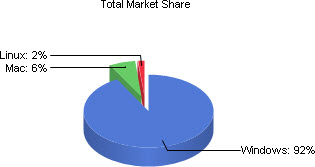Why Adobe is right to abandon Linux, why it's no big deal, and why this could be bad for Mozilla

Adobe has essentially abandoned Linux, with the company's latest roadmap barely mentioning the platform. But ultimately, Adobe is right to ditch Linux, and while this could be a blow to Mozilla's Firefox browser, overall it's not really a big deal.
OK, so why was Adobe right to abandon Linux?
Well, the usage share figures for Linux say it all really. Take this from NetMarketShare:Image credit: NetMarketShare
That chart there is a little optimistic in saying that Linux has a market share of 2 percent. In fact, it's 1.56 percent. You might be able to find a data source that gives Linux a better market share, but it's not going to be much better. In terms of current usage, and growth, Linux is dead in the water. Outside of the kernel forming the foundation for Android (that platform is going places) and server use, Linux is a fringe platform, and it's hard for a company like Adobe to justify continuing to support the platform.
Note: Also, as of Adobe AIR 3, that platform is also dead as far as Linux is concerned.
It's hard to spin 1 percent as anything other than 1 percent.
But why is it not a big deal?
But Flash isn't vanishing from Linux completely. Following the Flash Player 11.2 release for Linux, the only way to get on-going Flash support will be via the Google Chrome browser. Flash Player 11.2 will continue to see security updates for five years, but the only platform that will see new versions that bring new features and developments is Chrome.Yes, I did say five years. The Adobe Flash plug-in will be supported by Adobe for five years, but in web years that's a very long time indeed. While it does mean that users won't be able to make use of any new Flash features, it does mean that they'll still be able to make use of Flash on the web. And when support for the release expires in 2017, I doubt that anyone will be that bothered by it because we will have all moved on to a web powered by HTML 5.
Bottom line, it's hard to get worked up about this given that Linux will still support Flash for the foreseeable future. 11.2 will offer basic support, and anyone wanting the latest and greatest can jump over to Google Chrome.
So why might this be bad for Firefox?
It's not so much users I see getting caught up in the crossfire here over Flash, it's Mozilla. For years Firefox has enjoyed pride of place as the browser of choice for most Linux distros. This gave the browser a foothold among the greybeards, who in turn became evangelists for the web platform.But now there's a new kid of the block, and it has an ace up its sleeve. If Google Chrome is the only browser that can deliver the latest Flash experience to Linux, then I can see the browser making an appearance. maybe initially it will be installed alongside Firefox, but I could see the day when Chrome becomes the new Linux darling.
This a big deal for Firefox because the browser is already in rapid decline and it's giving ground to Google Chrome:
Image credit: NetMarketShare
Linux isn't itself a huge market, it's a segment that's been loyal to Mozilla and Firefox, but given how bad things have gone for Firefox since Chrome appeared on the scene, being sidelined in Linux could be the last straw.
So all you Linux users can stop panicking!
